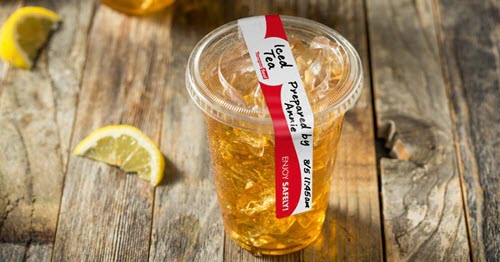Off-Premises Trend Drives Packaging Innovation
Posted on 11th Jun 2021
 Growth of takeout, delivery go hand-in-hand with efforts to protect health, safety and product integrity.
Growth of takeout, delivery go hand-in-hand with efforts to protect health, safety and product integrity.
The trend toward off-premises dining had already been gaining momentum before the COVID-19 pandemic took hold, but the events of the past year have accelerated that shift.
This has forced many foodservice companies to rethink areas of their operations, including menu and packaging, to protect the health and safety of their guests and ensure that products maintain their integrity in transit. Products were reformulated or eliminated, and packaging innovations such as tamper-evident seals became ubiquitous.
All segments of the restaurant industry report that sales for off-premises consumption, whether through delivery, drive-thru or takeout, increased significantly as a percentage of overall sales during 2020, according to the National Restaurant Association’s 2021 Restaurant Trends Survey.
The survey also reported that 68% of consumers say they were more likely to purchase takeout from restaurants than they were before the pandemic.
Meanwhile research from NPD Group’s CREST found that restaurant delivery alone grew 124% in the 12 months through March of this year, compared with the preceding 12 months.
“It’s unlikely that digital ordering will grow at the same pace it has during the pandemic once restaurants fully open, but it’s table stakes for restaurants now,” says David Portalatin, NPD food industry advisor. “Digital ordering is all about elevated convenience and ease, and that’s what makes consumers tick.”
Noncommercial offsite growth
Noncommercial foodservice operators have embraced the off-premises trend, and many say they expect demand to continue even as more dining rooms reopen.
In the near term, the onset of warmer weather is prolonging demand for takeout and grab-and-go at the University of Massachusetts in Amherst, says Bob Baker, executive chef of residential dining.
“We’re returning to some in-person dining, but some students are still taking food out and having picnics outside in small groups,” he said in a recent Food Management webinar.
Baker and his team at UMass, as it’s known, spent a lot of time revamping its recipes and packaging to be more takeout-friendly, he says, and they were not alone.
At Florida A&M University in Tallahassee, foodservice provider Metz Culinary Management is partnering with Grubhub to allow students to place pickup orders on the Grubhub app from several on-campus dining locations. Other Metz off-premises initiatives have included curbside meal pickup in K-12 accounts, and the newly rebranded and expanded Chef Fresh grab-and-go program in healthcare locations.
Increased health and safety efforts
For operators in hospitals, schools, colleges and universities, business dining accounts, sports stadiums and other noncommercial venues, the expansion of off-premises meal solutions such as grab-and-go displays or digital ordering for pickup or delivery have gone hand-in-hand with increased health and safety precautions.
Elior North America, for example, rolled out the Safe Café program, which focused on incorporating rigorous health and safety standards into its pickup and delivery offerings as well its new 24/7 self-serve marketplaces. It communicated its emphasis on health and safety with its customers through such media as signage, floor decals and packaging seals.
In fact, packaging has become a key consideration as onsite foodservice companies continue to refine their takeout, delivery and grab-and-go offerings.
“If we were to look at this year’s list of buzzwords, you can bet that it would include ‘safety’ and ‘sanitary,’” the Foodservice Packaging Institute concludes in its 2020 Trends Report.
Consumer demand for “contactless” foodservice experiences accelerated the innovations in foodservice packaging, the report notes.
“As restaurants looked to reduce exposure, there was an increase in packaging products that create a barrier between individuals and food, particularly ‘tamper-resistant’ and ‘tamper-evident’ packaging,” the FPI says in the report. “As food is transported in new and different ways, whether through contactless pick-up or third-party delivery, continued packaging innovation ensures the experience is as touch-free as possible.”
In California, tamper-evident food packaging became required by law last year for third-party delivery orders, following reports of food that may have been contaminated during delivery—possibly by hungry or thirsty drivers.
DayMark’s TamperSeal labels solve this issue for foodservice operators. TamperSeal labels feature an aggressive adhesive that sticks to most packaging materials safely and securely. Each label has security slits that cause the labels to lose their integrity if someone attempts to open the container, providing clear evidence that food may have been tampered with.
“This visual indication delivers peace of mind to delivery customers who are reassured that the food they’ve ordered from their favorite foodservice establishment is safe to eat,” says Debbie Leifer, category manager of Food Safety Tech at DayMark.
In addition, TamperSeal allows foodservice operators to customize the labels with their own branding and to select from an assortment of shapes and sizes to suit all types of food and beverage packaging. When used with the MenuPilot app and Matt85 printer, content such as date codes, a company logo and other types of customized information can be printed on the label.
For more information about how TamperSeal labels can help secure your off-premises solutions, visit DayMark Safety Systems.
Article originally appeared on the Food Management website.


